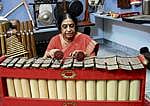

This bamboo flute from Thailand is just one of the many exotic musical instruments from around the world that this feted Indian classical musician has housed in a room at her home in Bangalore. It is officially called Institute of Ethnomusick and has about 300 musical instruments from around the world and counting! The rarity of these instruments has made this museum a must-visit for music-lovers.
Among those who have visited are Karnatik music giant M Balamuralikrishna, doyen RK Srikantan, renowned percussionist Vikku Vinayak Ram, violin maestro Lalgudi Jayaraman, famed musicologist and dance scholar Pappu Venugopal Rao, well-known vocalist OS Thiagarajan, besides respected musicians like SAK Durga, VV Srivatsa, VKrishna, Suguna Purushottaman, etc.
“The collection started with a swara mandal by Ustad Mohammed Husain Sarahang and his father. The second was a rubab. And then the collection just grew, acquiring a momentum of its own,” she says. The sheer number and range of these instruments, has to do with two factors. The first is Anasuyaa’s own eclectic musical training––she has learnt, taught and performed Hindustani and Karnatik vocal music. Her gurus for vocal music included RR Keshavamurthy and Mysore T Chowdaiah. She has also been amazingly open-minded about world music––willing to learn from any genre, and cultural influence she has been exposed to.
And she was exposed to the world, thanks to her husband NR Kulakarni’s career with the United Nations. So she lived in––Afghanistan, Mongolia, Indonesia, Papua New Guinea, Uganda, Ethiopia and Bhutan. The couple also visited Kenya, Zambia, Singapore, China, Philippines, Fiji, New Zealand, Tanzania, Thailand, Mauritius, Australia, etc.
“Everywhere, besides listening avidly to the music of a region, I would also, often, purchase and learn to play on the local musical instrument. In learning I would be helped by local musicians and music schools/universities. I would often teach them Hindustani or Karnatik music in return, informally or under exchange programmes!”
When in Indonesia, she mastered the local musical instrument, angklung, a rattle made of bamboo, to the extent that she was sent as the government’s official representative to the Indian Ocean festival at Perth!
Right now, she is also famed for her full-length concerts on an Indianised angklung. “The angklung is a group-performance instrument with detachable pieces––each musician takes out one piece and plays under the directions of the music conductor. I have selected a few pieces suitable for Indian music, designed a stand for them and made two scaled-down versions (with eight and nine-pieces respectively). And rechristened it Ankrang. On it I play Karnatik, light, and fusion music besides a little Hindustani.” she explains. In 2008, she entered the Limca Book of Records for introducing and performing this Indian version of angklung.
Of course, the museum has benefitted from her willingness to spend on building a collection. But most collectors don’t seem to mind saving for and splurging on their collection. Here, it was Anasuyaa’s husband who willingly paid for all the instruments since he shared her passion. “But it is always called Anasuyaa’s museum!” he says in mock protest. And then adds with a laugh: “In effect, I get the debit and she gets the credit!”
Kulakarni also shares a lot of the maintenance responsibilities. The couple ensures that the museum is always clean, and all instruments are in working condition and neatly labelled.
The four recognised categories of music instruments are all represented here––aerophones, idiophones, chordophones and membranophones. Most of them are exactly as they were bought while a handful have been modified––like the gong from Bali in the drawing-room which has been accessorised with seven Indian bells which, when struck, sound the sapthaswaras (seven notes).
There are plain, staid instruments like the morchings and ghatams, and ornamental-looking ones like the dramyan (from Bhutan).
There are tiny flutes and large Indian veenas and African drums. Best of all, it is a living collection––Anasuyaa teaches these instruments to select musicians and holds group performances of the same with these students, besides giving lecture demonstrations on the music of these instruments.
It is truly a labour of love for the couple and their only reward is the joy that the music lovers experience while enjoying their lovingly collected treasures.
